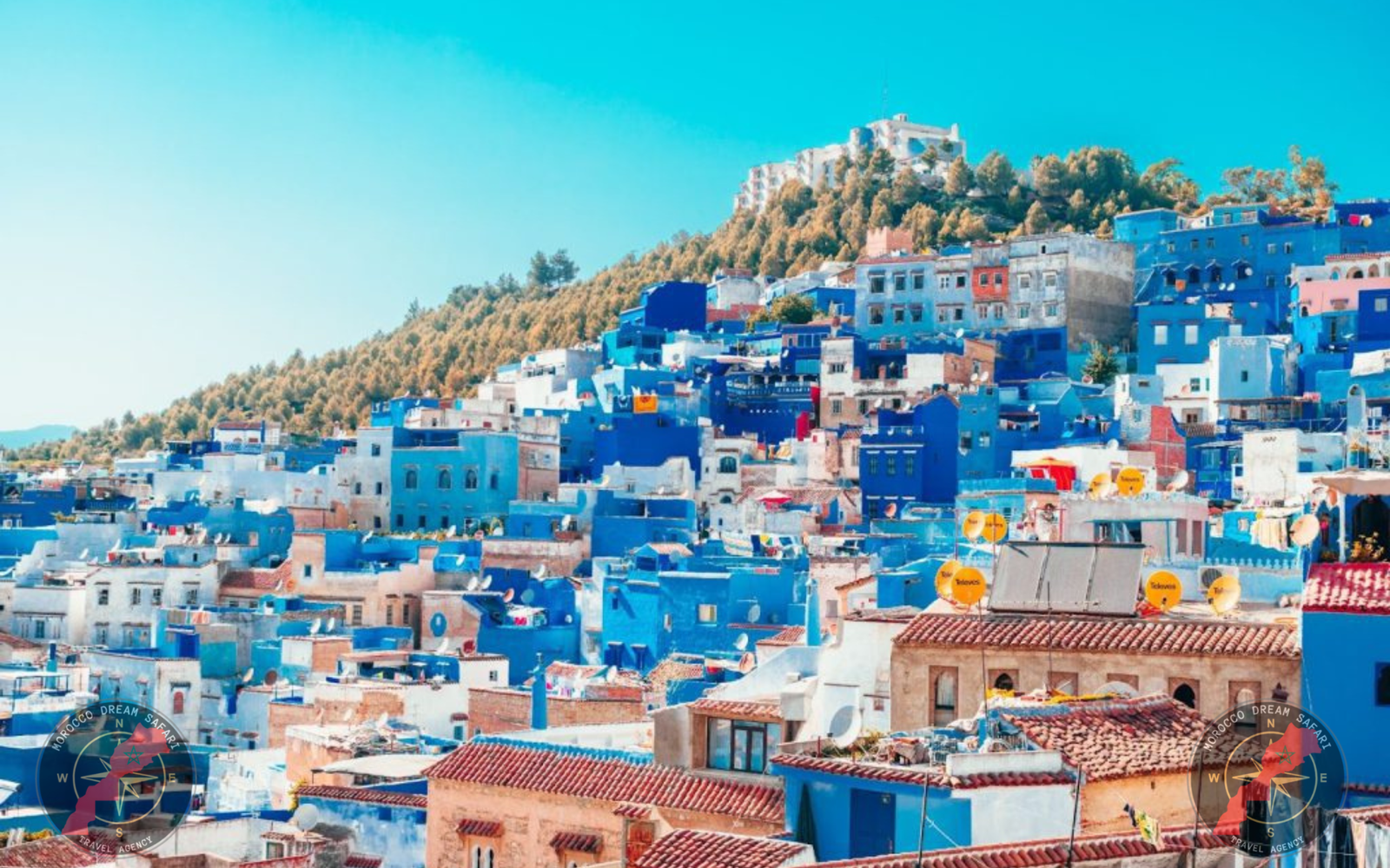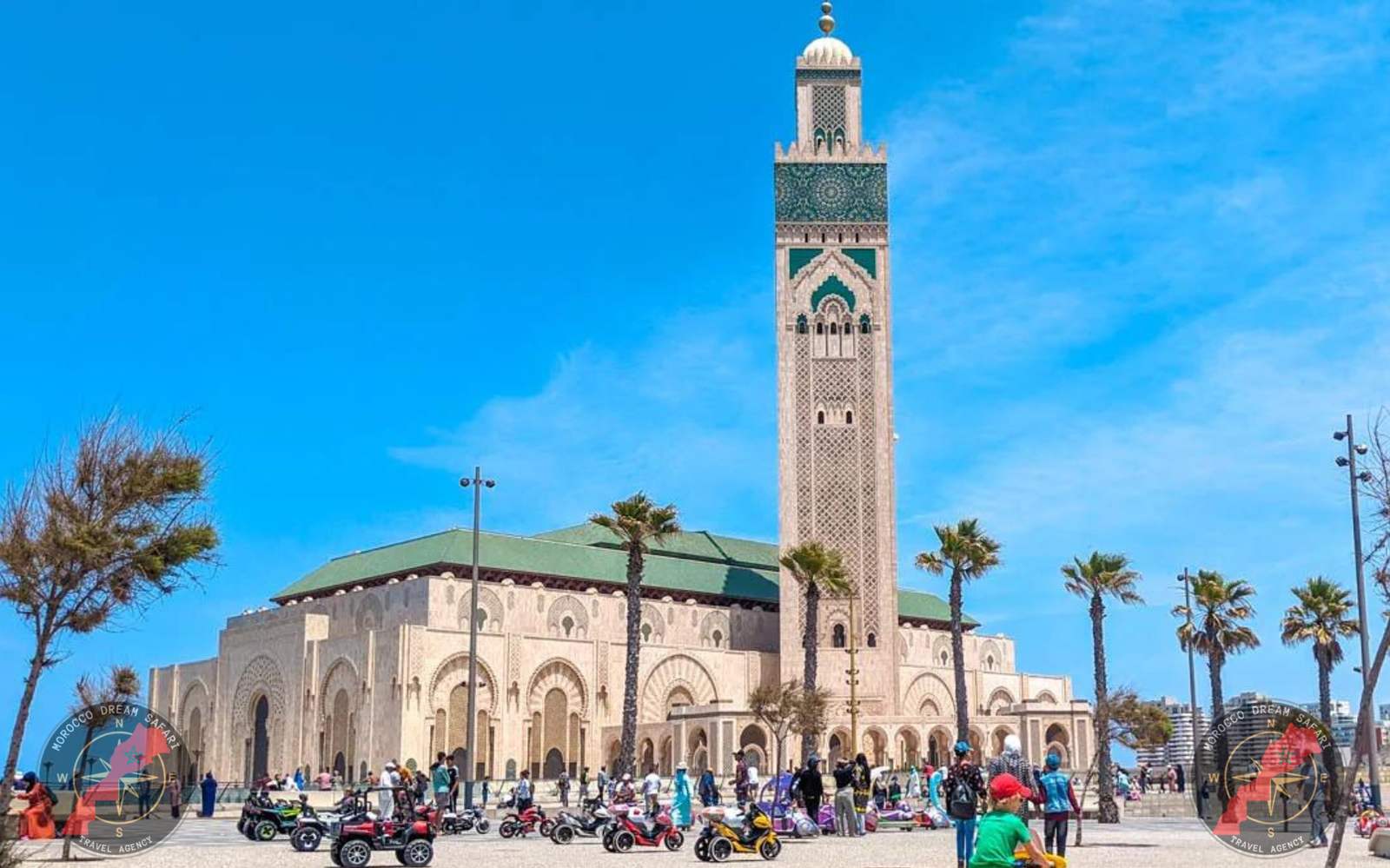Day 1: Tangier » Chefchaouen
Morocco, welcome! Arrive in Tangier, the harbor city and the gateway between Africa and Europe. You will have the option of spending time in Tangier or continue on to the beautiful blue city of Chefchaouen in the Rif Mountains. Just before arriving in Chefchaouen, take a 2- to 3-hour climb through lush foliage and little lakes to see the Cascades d’Akchour (Akchour Waterfalls), a hidden beauty. Arrive in enchanting Chefchaouen from there. Explore its maze-like small lanes and passageways that cling to the northern hillside of its old medina, known for its blue-washed structures.
Discover Place Outa el Hammam, the main plaza named after the number of hammams (public baths) that once surrounded it. Find a restaurant or café for a bite to eat before exploring the various stores selling traditional goods. Visit the Grand Mosque and the kasbah (ancient fortress or fortification). The Mosque was erected in 1560 and is not open to non-Muslims (though the vista from the outside is still worth seeing). Explore the kasbah and see a garden, a museum, and even some of the old prison cells.
As nightfall approaches, take the streets east and ascend the path leading to the white Spanish Mosque (20 to 30 minutes). As the sun sets behind the mountains, take in one final look at Chefchaouen.
Day 2: Roman ruins at Volubilis » Meknes » Cultural Capital of Fes
Before departing Chefchaouen, get up early and walk the peaceful streets for the finest opportunity to take unimpeded shots. Make your journey to Fes, stopping briefly to view the spectacular Roman remains at Volubilis. Volubilis, a UNESCO World Heritage Site, is a huge complex worth seeing. It was founded in the third century BCE and abandoned in the 11th century, yet it has survived remarkably well. Admire the merchant houses with apparent heating systems beneath, the temples, and the remarkably intact vivid mosaics in situ, especially Hercules’ Labors.
On your journey to Fes, make a stop in Meknes. Meknes, a smaller version of Fes, with a quieter medina and vendors who aren’t as eager to make a sale. While Meknes is a huge city, the two main points of attraction are the Imperial City and the manageable Medina.
Continue on to Fes, where you may explore the amazingly huge and intricate medina that runs down the hill. Before traveling into the medina, stop by the Merenid Tombs for a panoramic perspective of the old city. Stay in a lovely riad in the medina (complete with an indoor courtyard garden).
Day 3: Exploring the Imperial City of Fes
The third day of our 7 days tour Imperial Cities of Morocco tour will be an exploration of the city of Fes. The journey will begin in the morning at your lodging. Your local travel guide will meet you at the Madrasa Bou Inania to take you there. In AD 1351-56, Abou Inan Faris established an architectural school. Non-Muslims are permitted to enter one of Fes’ sacred monuments. It is also recognized as a center for teaching youngsters the Quran and other Islamic subjects.
Second, we will go to Fes El Bali, also known as Fes’s old city. The majority of the local riads (hotels) can be found there. To get there, go via the “Bab Boujloud” main gate. Several well-known souks and old Moroccan sites can be found here. For example, the Al-Andalus mosque, Medersa Sehrij.
Third, you and your guide will visit the Chouara tanneries, which are known as the largest in the cultural city. It is the home of various handcrafted leather items. The painters only use unique spices to paint the leather, and it is entirely dried by the end of the day. It is recommended that you visit the surrounding roofs owned by the shop’s proprietors for the best views.
Another destination will be the Jewish Quarter, often known as Mellah. El Jedid, a well-known landmark in Fes, portrays how the Jewish population in Fes lived in the early twentieth century.
Day 4: Fez » Rabat » Casablanca
Spend the morning discovering more of Fes. Visit a local Ceramics and Tilework Collective to witness the tile masters at work producing their stunning mosaics.
It’s time to go west to Rabat, Morocco’s capital city on the Atlantic coast and the Bou Regreg River. Explore the Chellah Necropolis, a medieval fortified city at the heart of Rabat. Explore the lovely grounds, which include Roman and Islamic ruins. Step through the magnificent entryway of the Kasbah des Oudaias and into Rabat’s original site. Today, the area is mostly residential, so stroll the tranquil white and blue-washed streets and converse with the people. Pay a visit to the Andalusian Gardens. The gardens, built by the French in the twentieth century, provide a tranquil haven away from the masses. Discover the Hassan Tower, an incomplete mosque’s minaret, and the Mausoleum of Mohamed V.
A failed project in the 12th century. All that is left is the 145-foot-tall (44-meter) red sandstone tower and 200 columns, which serve as support components for the envisaged mosque.
Finish the day in Casablanca and check into your accommodation.
Day 5: Casablanca » Marrakech
If you only visit one attraction in Casablanca, Morocco’s commercial city, make it the Hassan II Mosque. Its 690-foot (210-meter) tower, which sits in a magnificent setting on the sea, is Morocco’s highest structure and the world’s tallest minaret. While the facade and surrounding area are beautiful, what makes this mosque even more unique is that it is one of the few mosques in the country where non-Muslims are able to attend. Join a morning tour of the mosque and marvel at the outstanding artisanship: hand-carved stone and wood, beautiful marble floor carving, and gilded ceilings.
After that, browse the Hobous medina’s stores. It was built by the French in the 1930s and is a great place to get a flavor of art deco architecture while exploring the olive, vegetable, and spice markets. Take a leisurely stroll along the Boulevard de la Corniche, Morocco’s Miami-style beach promenade that parallels the Atlantic coast. Rick’s Café, a restaurant, bar, and café created to imitate the bar made famous in the film Casablanca, is a must-see for movie buffs. Leave the seashore and travel three hours south to the Red City of Marrakech.
Day 6: Exploring the Red City Marrakech
Unlike Fes, Marrakech has Berber roots and history rather than Arab roots and history. It was formerly an important trading hub for Atlas Mountain tribes and is still a key economic center today. Orient yourself around the Jemaa el-Fna Square, with the souks to the north, the Koutoubia Mosque and Gardens to the west, and the Kasbah district, which includes the Saadian Tombs, Bahia Palace, and El Badi Palace, to the south. Majorelle Gardens may be found in Ville Nouvelle. Meet your guide and begin experiencing the vibrant city of Marrakech!
Spend time visiting the stalls in Souk el-Attarin (Spices), Souk Haddadine (Blacksmiths), and Souk Smata (Slippers). Take note of the huge open spaces and courtyards as you go about. These Fondouks or Caravanserai were previously inns frequented by visiting tradesmen and merchants who slept on the top levels while their animals rested on the lower floor. End your afternoon in the Jemaa el-Fna Square, just in time for it to come alive with musicians and storytellers, acrobats and dancers, and even snake charmers. As the sun sets, numerous rows of food stalls will materialize, providing everything from entire dinners to fruit drinks and dry dates. For a more relaxing experience, grab a snack and a glass of fresh mint tea at one of the many cafés perched over the square and take in the sights.
Day 7: Depart Marrakech
Complete any last minute shopping, or you may wish to spend additional time exploring Marrakech’s sites such as the ornate Bahia Palace (Bahia translates to ‘brilliance’). The Palace was built in the 19th century and showcases Islamic and Moroccan architecture and artisanship at its finest. It covers eight hectares (10,000 square m) of ground and includes a garden with rooms opening onto courtyards. A visit to the palace and its gardens offers the perfect place for quiet contemplation before catching your flight home.








